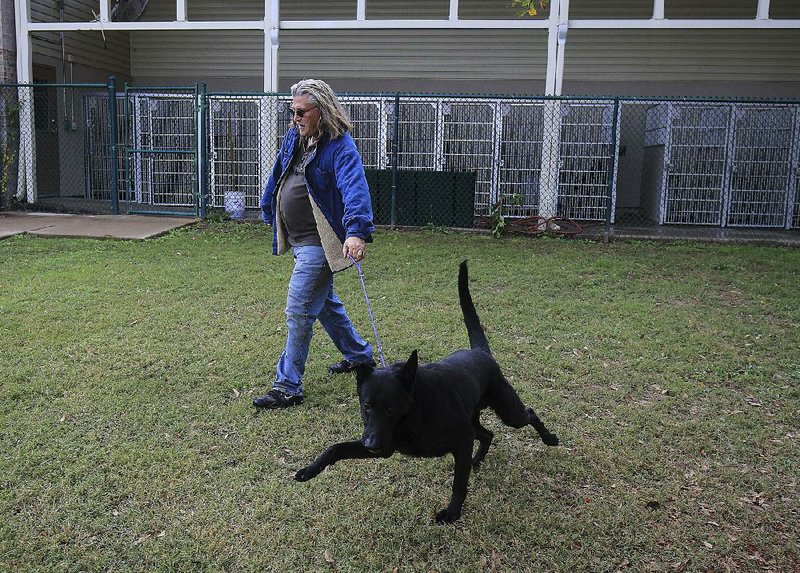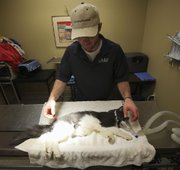There wasn't a touch of knowing in the dog's almond-shaped eyes when David Miles unhinged the latch to its kennel.
The unnamed dog had been at the North Little Rock Animal Shelter for three days, but no one arrived to claim it. The dog let out a hoarse bark as it struggled playfully against the leash Miles slipped over its broad face and square jaw.
The pit bull couldn't have known that its genes were condemned by a North Little Rock ordinance.
"It's his day," Miles said, and he led the dog away.
Miles is in his first year as the director of North Little Rock Animal Control, and, to his dismay, euthanasia is a near-daily routine. In 2015, just over 40 percent of the 2,400 animals the shelter received were adopted or reclaimed, leaving roughly 58 percent to euthanization. Twenty-one percent of the dogs euthanized were pit bulls.
Keeping euthanization numbers as low as possible is a daunting task for Miles and his seven animal-control officers. In addition to North Little Rock's jurisdiction, the shelter is also contracted to receive strays collected throughout Pulaski County. And while 40 percent of the shelter's intake in 2015 came from Pulaski County animal-control officers, the county's contract funds just 12 percent of the shelter's $808,000 annual budget, according to data provided by the city.
The county also pays Arkansans for Animals $50,000 annually for a spay-and-neuter program -- an amount that Miles said "is something, but in the grand scheme of things, it's nothing."
To address the shortcoming, last week the Pulaski County Quorum Court authorized an ordinance to create a donation fund to buttress the sterilization program. On personal property tax bills next year, county residents will be able to voluntarily pay $5 designated for spay and neutering services. The fund would expand the program and help subsidize sterilization costs, helping to drop the $70 cost for the procedure down to $45 for more pet owners.
"We've done no advertising in the last four years, and I'm booked eight weeks out," said Jake Hillard, executive director of Arkansans for Animals. "So imagine if we promoted the importance of spaying and neutering pets and imagine what the impact would be. I couldn't meet that [demand] at this point, and that's what this ordinance is for."
According to Humane Society statistics, one female dog and its progeny can produce 67,000 dogs over six years.
In Pulaski County, Arkansans for Animals estimates that about 30 percent of all owned cats and dogs are unsterilized, and between 11,000 and 12,000 pets course through the county's several nonprofit and municipal shelters each year. In total, $4.5 million is spent annually picking up and sheltering lost pets or stray animals.
James Tindall has been an animal-control officer with North Little Rock's shelter for five years. Like Miles, Tindall has cared for animals since his teenage years, and he betrays a heavy heart when discussing the darker side of his job, the necessary evil.
Euthanasia, he said, is often a humane answer to animal homelessness, suffering or irredeemable aggressiveness. But among the public, when he's in the field, misconceptions prevail. For years, he said, he's endured the stigma cast upon him -- dog killer, he's often been called.
"That's the only thing they see, and that's so unfair," Tindall said. "Because it's the public's irresponsible nature of not spaying and neutering that causes the issue."
The only way to avoid having to put down any animals, he said, would be if adoptions increased threefold and if intake numbers were mitigated by more sterilizations.
Nonetheless, North Little Rock's Animal Control has recovered since the city's "Dogtown" days, a nickname that oral tradition attributes to Little Rock residents dumping their unwanted dogs in the neighboring town.
Miles recalled the years when packs of dogs paced the city's streets, an issue that -- thanks to heavy enforcement of the city's ordinances in the past decade -- is no longer as pressing.
"We'd have 10, 15, 20 dogs running in packs along the river, and every year you might miss one or two, and then next year there's a whole other litter," Miles said.
In Little Rock, under the guidance of Director Tracy Roark, Friends of the Animal Village has seen intakes drop and adoptions spike.
In 2003, the facility euthanized 3,147 dogs and cats and sent 386 to new homes. So far this year, euthanization numbers are down to 780, and adoptions and transfers have increased to 2,315.
Roark credits several things for the stark turnaround, one being how easy the shelter has made the adoption process in order to flood the pet market with sterilized animals. But more importantly, the dozens of nonprofit rescue groups -- notably the Central Arkansas Rescue Effort for Animals and the Friends of Animals -- that take the animals that have exhausted all other means of adoption.
"Usually when they're pulling a dog, that's the last chance that dog will find someone," Roark said.
That kind of community support is paramount to municipal shelters that have put a complete moratorium on needless euthanization.
Austin, Texas, for instance, achieved "no-kill" status in 2010 after its nonprofit groups -- which now number over 150, an official said -- compelled the city government to increase funding and ensure survival rates steadied above 90 percent.
Funding for the shelter has more than doubled over the past 10 years, and survival rates have risen from 50 percent in 2007 to 96 percent today. In that period, the animal-control service has shifted its focus from holding loose or stray animals in shelter kennels to returning them to their rightful homes while in the field.
"I don't think that spay and neuter is a catch-all," Austin spokesman Patricia Fraga said. "It's the community support, it's a lot of outreach, it's awareness. Spay and neuter is not going to solve your problem [on its own]."
North Little Rock officials said they see no clear path to no-kill status. At the end of the day, the shelter also serves as a component of public safety.
"No one wants to hear we kill dogs. But the only way we could be a no-kill shelter is if we were a no-take shelter, and that will never happen," North Little Rock spokesman Nathan Hamilton said. "Because if someone comes in and says, 'I found this stray dog and it's trying to bite kids,' we're taking that dog and we're not going to adopt it back out. Because it's a matter of public safety."
Efforts to bolster spaying and neutering through state legislation have also been tried -- and have failed.
Like a majority of states, Arkansas' only state statute related to animal homelessness requires the sterilization of shelter animals before their release. But during the 89th legislative session, Rep. Eddie Armstrong, D-North Little Rock, attempted to promote efforts to stem the tide of unwanted animals.
In 2013, he filed House Bill 2160, which laid the groundwork for mandated spay-neutering requirements. Under his bill, local governments would be allowed to opt into mandatory sterilization ordinances and levy minor citations against pet owners with unsterilized animals. It also would have created a corresponding licensing program that would permit only certain pets to remain intact.
But the bill quickly ran aground as unexpected opposition emerged, primarily from rural constituents, he said. It never left the committee, and it was deferred to interim study, where it has since sat untouched.
"I had no idea it was going to be as big of an issue. But when you start talking about individuals' pets and what they should do..." he said, trailing off. "I thought I was just doing some common goodwill for my city."
Armstrong has no plans to take the bill back for consideration during next year's session, he said. However, he hopes the approval of Pulaski County's donation fund regenerates interest in the subject among his legislative colleagues.
County officials can only speculate how much the $5 donation option might reel in. Faulkner County implemented a similar fund about 11 years ago, which has so far generated $1.2 million -- all so far unspent, county officials said.
Similarly, Saline County's Animal Control Fund, established in 2012, has collected $300,000, which goes toward general operating expenses, according to the county's collection reports.
And while Pulaski County's Quorum Court was resolute in the measure -- passing it unanimously -- county Tax Collector Debra Buckner has some qualms over incorporating the $5 contribution check-box into her tax-collection software.
It's not so simple, she said.
For that task -- which would be carried out by Buckner's software provider -- she would need another $50,500 in her budget. Quorum Court members will vote on the expenditure next month.
But she agrees on the benefits of the measure.
"It should have been done long ago," Buckner said.
Metro on 11/27/2016


